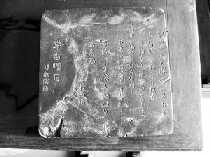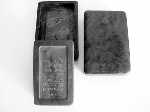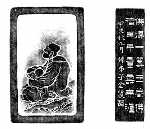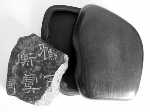Chinese calligraphyhas Four Treasures of Study -Wenfangsibao, orwriting brush, ink stick, ink slab, andpaper. These four traditional 'treasures' have played an important role in disseminating culture and art in China, and with the passing of time, ink stones have became art works themselves.
A look into the origin, selection of the raw materials, special varieties, and making of the famous ink slabs reveals the historical, cultural, and aesthetic values throughout Chinese history.
Ink slabs originated from the grinding implements used in primitive Chinese society to grind pigment on stone. There is a lot of archeological evidence to show that ancient Chinese used ink slabs for grinding ink. A stone ink slab was found in a 5,000-year-old archeological site in Jiazhai,Shanxi Province. In theHan Dynasty(206BC-220AD), ink slabs were widely used as writing utensils.
After many years of development, the craftsmanship of making ink slabs consummated in the Ming (1368-1644) and Qing (1644-1911) dynasties, with a lot of famous ink slabs produced. The Ming era ink slabs were made according to the original shapes of the stone, and various forms like lotus leaves, men's faces, crescents, ancient coins, and gourds were finely carved into the stone. By the Qing era, ink slabs more importance was attached to inscription and decoration, and ink slabs had become artistic works for collection rather than merely for practical use.

Seven-star string instrument ink slab.

Duan ink slab with inscription of Mi Wanzhong in the Ming Dynasty.

Ink slab collected by Huang Shentian of the Qing Dynasty. On the back is his inscription.
Most ink slabs are made of stone, while are made of porcelain,bronze,or lacquer. Three of the so-called Four Famous Chinese Ink Slabs are stone, and only one is porcelain.
What makes a valuable ink slab?
The following three characteristics are critical for prime quality ink slabs. First is the texture of the material. Among all the ink slabs from the different regions in China, Guangdong duan ink slabs usually get the highest price - largely due to its fine texture. Second is the craftsmanship of the carving. Third is the shape of the ink slab. Generally speaking, rectangular and round shapes are more expensive than regular ones.

Cultural background is also of great importance to the value of the ink slabs. Those with inscriptions of celebrities usually hit the highest price on the market. Unlike other works of art, a long history does not necessarily mean a high value. The ink slabs in the Song (960-1279), Tang (618-907), and Han (206BC-220AD) dynasties are usually made of stone of inferior quality. In the Ming (1368-1644) and Qing (1644-1911) dynasties, the literati had much higher requirements for the texture of their stones, so the price of these ink slabs is usually higher. Though boasting high collector values, the more ancient ink slabs, like Han era ink stones, are sometimes sold for relatively lower prices.
Maintenance of ink slabs
The prime requirement to maintain an ink slab is to avoid direct sunlight, or it will become too dry, and the ink slab casket tends to crack in low humidity. A high-quality ink slab should not come into contact with metal, glass or other ink slabs , and felt should be used to cushion the desk..
Four Famous Chinese Ink Slabs
Anhui She Ink slab
As one of the essential tools of inkbrush painting, she ink slabs, produced inAnhui Provincein East China, were one of the most sought after collector's items among the literati and elite for thousands of years. This is one of the so-called Four Great Ink Slabs in Chinese history.
It is named after Shezhou Prefecture, Anhui Province, where it was first produced in theTang Dynasty(618-907). Many counties under the jurisdiction of this prefecture produce she ink slabs, but the best come from Longwei Mountain in Wuyuan County. Sometimes she ink slabs are referred to as longwei ink slabs.
She ink slabs are made of gray, light green, or rare black slate with markings, the stone looks layered and is hard. She ink slabs have three features: they form ink quickly, don't harm the brush, and keep the ink wet.
She ink slabs have a special artistic style with different markings resulting from geological changes over time. Typical markings are Gold Star, Gold Star Patch, Gold Line, Silver Star, Silver Line, Cherry Blossom Gold Star, and Small Water Wave. Rarer ones are Eyebrows,JadeBelt, Jade Belt with Gold Star, Big Water Wave, Fish Egg, Dates Kernel Eyebrows, Jade Patch, etc.
Anhui Province was part of an ocean 13 billion years ago. Through glacial and volcanic movements, mud and other substances formed these rare ink slab slates. This is part of the reason why she ink slabs are so costly.

Chengni ink slab owned by Jin Nong, a member of "Eight Eccentrics of Yangzhou" of the Qing Dynasty.

A Qing ink slab made from an incomplete stele of the Eastern Han Dyansty.

Zhao Mengfu's Duan ink Slab.
Gansu Tao Ink slab
Tao ink slabs from Lanzhou,Gansu Provincein west China are acclaimed as one of the Four Famous Ink Slabs in China, along with the duan ink slabs ofGuangdong Province, the she ink slabs of Anhui Province and the chengni ink slabs of Shanxi Province. Tao ink slabs have a long history and became famous during the Song Dynasty (960-1279).
Produced mainly in Taoyan Village in Zhuoni County, Tao ink slabs are made of stone found at the bed of the Tao River; hence the name. It has four main kinds: Duck-Head Green, the best of the four in terms of quality, with light green, water-like lines and hard in nature; Parrot Green with a dark green and smooth surface; Osier Green in green mixed with vermilion, and with hard nature; and Light-Green, featuring the flowing lines of water.
One feature common to all four kinds of ink slabs is that the stone is hard and fine. Though hard, the stone is not dry. Though fine, it is not slippery. With a hard, smooth stone you can produce liquid ink easily by rubbing the ink stick against the stone. Because the stone is fine, but not slippery, it yields ink very quickly.
The ink slab's fame lies in its beauty and style and good quality, usually decorated with various fancy pictures of things likedragons, phoenix, tortoises, mountains and water, figures, flowers and birds. In the past, it was a favorite collectable of celebrities. The Gansu authorities choose Tao Ink Slab as a present to the Special Administrative Government whenHong Kongofficially returned to China in 1997. The most famous aspect of the ink slab is that when its lid is on, the lines and patterns of the original stone merge with the lid line to give the impression that the stone is whole.
Guangdong Duan Ink Slab
Produced inZhaoqing, Guangdong Province in south China, duan ink slabs are another of the Four Famous Ink Stones.
According to historical documents, duan ink slabs were first produced during the Wude reign (618-626) of the Tang Dynasty (618-907). They are made of duan stone from the Duanxi River running along the foot of Lanke Mountain, hence the name. Famed for their fineness and for not harming the brush, duan ink slabs have earned a high reputation among Chinese scholars.
The procedure to make a duan ink slab has four steps: stone picking, selection, engraving and box matching; of which stone picking and engraving are the two most important. It is very hard to handpick flawless stones, and other alternative tools such as dynamite are forbidden. Engraving stresses the good origin and fine shape of the stones. Engravings are usually of flying dragons, flowers, birds, figures, mountains and water. The matching boxes are also very delicately chosen, and are often made of purple sandalwood and rosewood.
Duan ink slabs have various styles, and new-style products are designed one after another, such as doufang ink slabs -, engraved rectangular ink slabs and engraved natural ink slabs, etc. In recent years, lots of ink slabs with an old look have been produced to meet increased export demands.
Shanxi Chengni Ink slab
Last but not least are chengni ink slabs, produced inXinjiangCounty, Shanxi Province in northern China. They differ from most other ink slabs because of the production methods. Instead of using a big chunk of hard rock, the stone is made from the soft soil from local riverbeds.
Chengni ink slabs originated in the Tang Dynasty (618-907) and were then a precious tribute item. Unfortunately by theQing Dynasty(1644-1911), the craft of kilning the once famous chengni ink slabs had already been lost for various reasons. It has regained its past prosperity after unremitting effort by craftsmen in recent years.
The very fine mud under the bed of the Fenhe River is filtered, mixed with binding material, dried and carved into ink slabs, then fired in the kiln. Because of the different minerals in the mud and also the different temperatures used in firing, the final products have different colors. The process has nine steps: mud selection, filtrating, depositing, molding, baking, carving, firing, waxing and polishing. chengni ink slabs have the following characteristics: they generate ink easily, they don't harm the brush, and they are portable.
In terms of artistic design, chengni ink slabs now come in about a hundred different designs, with stress on patterns and shapes, using elegant and simple but beautiful colors.

